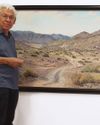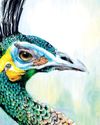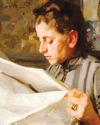Originally from Pretoria and now based in London, winner of the 2013 BP Portrait Award, Susanne Du Toit shares her philosophy on painting portraits.

I have always looked at people as the subjects of art, but I arrived at portraits late in my journey as an artist. The catalyst was a catalogue from a 2006 exhibition at the Met, in New York, Glitter and Doom, where I rediscovered German art from the interwar period, and especially the work of Otto Dix and the New Objectivity. Maybe it was because my technical training at art school did not include portraiture that I was so sensitive to the raw humanity of these paintings.
At any rate, lack of academic background has determined my own approach to portraits. Formally,
I do not think of a portrait any differently to, for instance, a landscape. I judge the success of a portrait foremost as a painting, or a work of art even. What I mean by this is that rules can only take you so far: a technically accomplished portrait does not necessarily make an interesting painting.
And so, I do not have any strict rules about portraits to pass on. For that, and for so much more, I can recommend Robert Henry’s book, The Art Spirit, which has been invaluable to me. I can only share what I find helpful and hopefully provide some tools to help a painter discover and pursue what they value in a portrait.
Let’s begin with the obvious: unless you are painting a commission, there needs to be a purpose, a particular vision behind any portrait. Wanting to make a portrait is one thing– but ask yourself, why this portrait. Such a goal could be to communicate the aura of an individual or a particular emotion, to capture a narrative or a scene that you find compelling, or, if it is the painting itself you are more interested in, to explore a certain colour or composition.
Esta historia es de la edición Issue 24 de The South African Artist.
Comience su prueba gratuita de Magzter GOLD de 7 días para acceder a miles de historias premium seleccionadas y a más de 9,000 revistas y periódicos.
Ya eres suscriptor ? Conectar
Esta historia es de la edición Issue 24 de The South African Artist.
Comience su prueba gratuita de Magzter GOLD de 7 días para acceder a miles de historias premium seleccionadas y a más de 9,000 revistas y periódicos.
Ya eres suscriptor? Conectar

Oil Painting Essentials
Tips and techniques: oils

Tips And Techniques: Watercolours
Tips and techniques: watercolours

How To Paint A Classic Autumn Scene
Who can resist painting an Autumn scene?

small towns & the big city
The sight of a print of Tretchikoffs "Dying Swan" on the wall at a friend’s house, when David Roux was only five years old, was the start of a lifelong interest in art.

life and landscapes
Johan Coetzee’s journey to becoming a full time artist began long before he went to college.

the shape of colour
FEATURED ARTIST: SHAKES TEMBANI
coloured roses in aquarelle
TIPS AND TECHNIQUES: GOLDFABER AQUA

colourful peacock
TIPS AND TECHNIQUES: CHAMELEON PENS

a South African artist makes his mark in New York
FEATURED ARTIST: LUKE BAGGOTT

Painting With The Zorn Palette
The Zorn palette is named after Anders Leonard Zorn (February 18, 1860 – August 22, 1920), an internationally successful artist from Sweden.